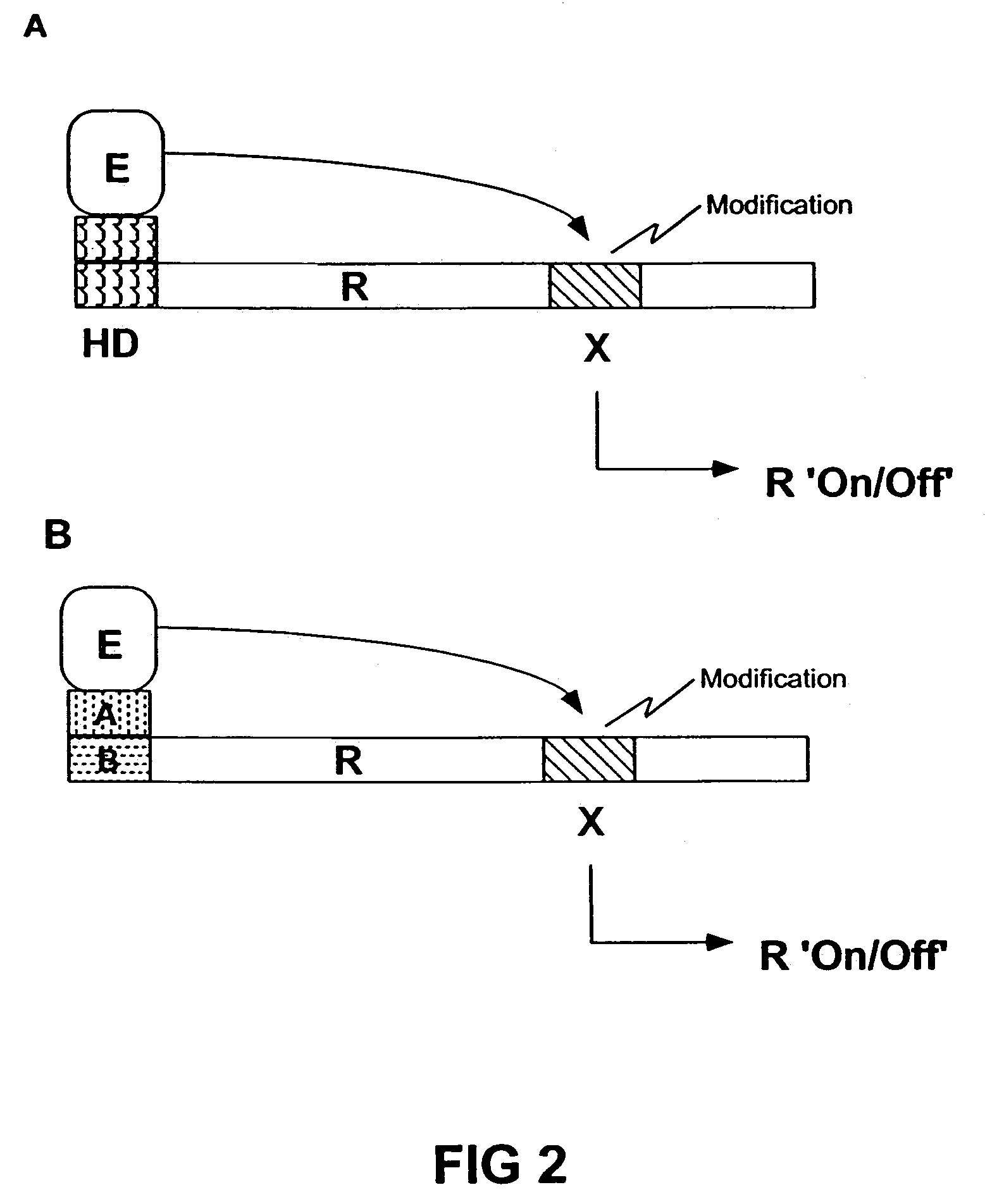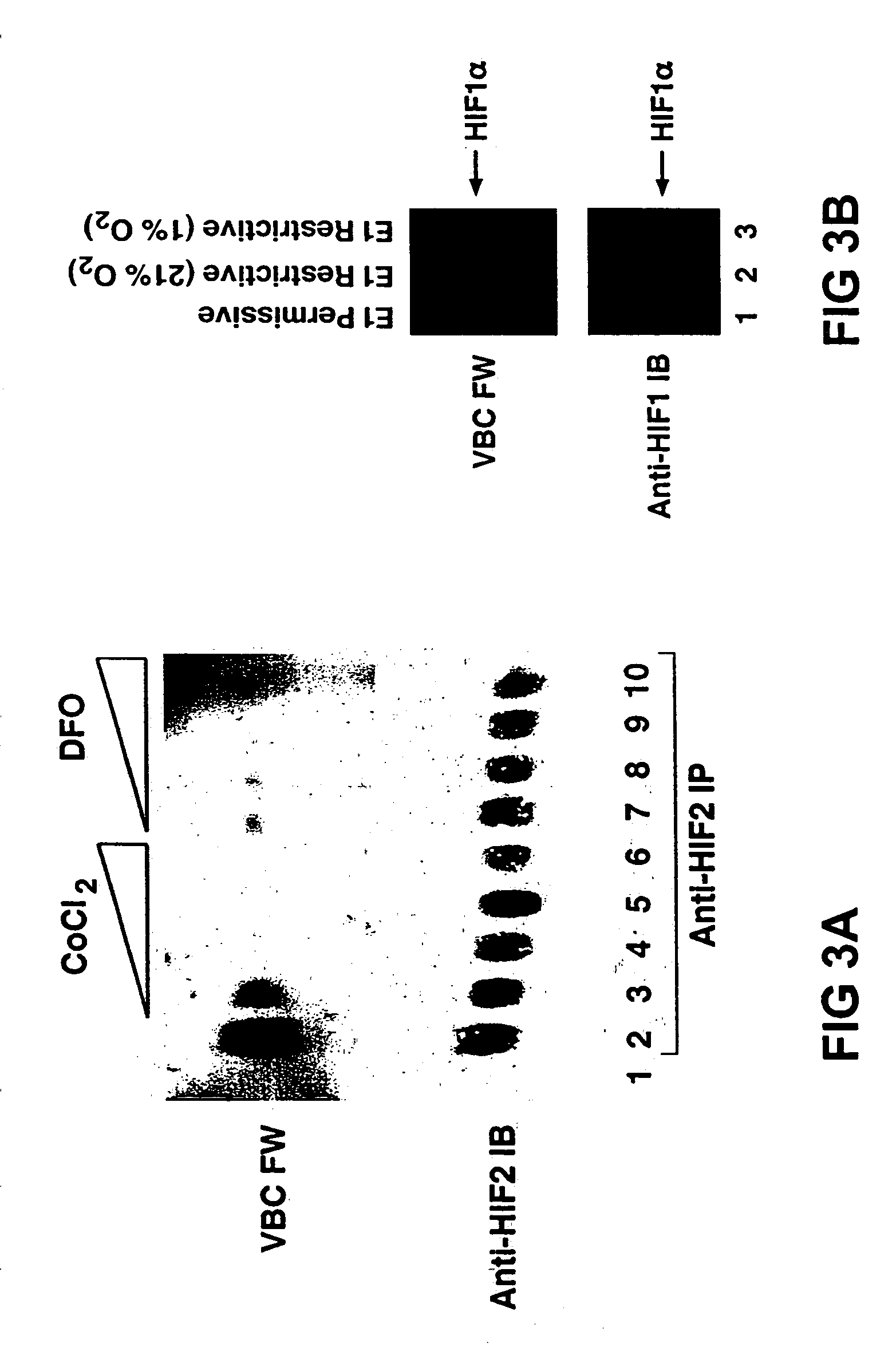Transgenic animals expressing light-emitting fusion proteins and diagnostic and therapeutic methods therefor
a technology of light-emitting fusion protein and transgenic animals, which is applied in the field of compounds, can solve the problems of tissue ischemia, major cause of morbidity and mortality, and the cells' sense of changes in ambient oxygen
- Summary
- Abstract
- Description
- Claims
- Application Information
AI Technical Summary
Benefits of technology
Problems solved by technology
Method used
Image
Examples
example 1
Characterization of Hypoxia-Responsive Polypeptides
[0226]In order to demonstrate the efficacy of the First embodiment of the invention, e.g. employing a hypoxia-responsive LGP, the interaction of pVHL and HIF was examined. A HIF1α polypeptide that is sufficient to bind pVHL is disclosed herein. pVHL binds directly to a region of HIF1α called the oxygen-dependent degradation domain (ODD). pVHL recognizes HIF produced in rabbit reticulocyte lysate but not HIF produced in wheat germ extracts or in E. Coli. Furthermore, wheat germ or E. Coli-derived HIF binds to pVHL following preincubation with a human, rabbit, or xenopus cell extracts at 37° C. For example, glutathione S-transferase-ODD fusion proteins produced in E. Coli were not recognized by VBC in farwestern assays (FIG. 3C). These proteins were recognized, however, after pre-incubation with a rabbit reticulocyte lysate. Similar results were obtained with GST-ODD fusion proteins of various sizes, thus excluding the possibility tha...
example 2
[0231]The following example demonstrates the efficacy of light-generating fusion proteins of the invention for imaging hypoxic tissues.
[0232]The Oxygen-Dependent Degradation Domain (ODD) of HIF1α, renders HIF1α unstable in the presence of oxygen. This region is recognized by pVHL. pVHL specifically binds directly to peptidic determinants, corresponding to HIF1α residues 555–575, located within the ODD. At the core of this peptide there is a conserved proline residue (residue 564) which, in the presence of oxygen, becomes enzymatically hydroxylated. This residue serves as the signal for pVHL to bind. In sum, in the presence of oxygen, the HIF peptide becomes hydroxylated and is recognized by pVHL. In the absence of oxygen (hypoxia), the modification does not take place and pVHL does not bind to HIF.
Construction of ODD-LUC Plasmids
[0233]In a first set of experiments the ability of a small HIF peptide (555–575) to function in cis to target a foreign protein for pVHL-dependent proteolys...
example 3
Light-Generating Fusion Proteins Including a DNA Binding Site
[0241]In order to demonstrate the efficacy of the Second embodiment of the invention, a LGP capable of interacting with nucleic acids in order to kinetically monitor gene transcription in vivo, in vitro or in silico, the impact of cyclins on transcription was examined. As it is useful to monitor either the induction or repression of transcription, cyclins with specific affects on transcription were investigated.
[0242]The kinase Cdk2, when bound to either cyclin E or cyclin A can direct the phosphorylation of its substrates. (FIG. 20.) Mammalian expression plasmids were made encoding fusion proteins consisting of the tet repressor DNA binding domain (TetR) fused to either cdk2, cyclin E or cyclin A. It was found that TetR-cdk2, as well as TetR-cyclin E, will activate transcription when tested against a luciferase reporter plasmid containing TetR DNA binding sites (TetO) upstream of a minimal promoter. Furthermore, we showed...
PUM
| Property | Measurement | Unit |
|---|---|---|
| Fluorescence | aaaaa | aaaaa |
| Luminescence | aaaaa | aaaaa |
Abstract
Description
Claims
Application Information
 Login to View More
Login to View More - R&D
- Intellectual Property
- Life Sciences
- Materials
- Tech Scout
- Unparalleled Data Quality
- Higher Quality Content
- 60% Fewer Hallucinations
Browse by: Latest US Patents, China's latest patents, Technical Efficacy Thesaurus, Application Domain, Technology Topic, Popular Technical Reports.
© 2025 PatSnap. All rights reserved.Legal|Privacy policy|Modern Slavery Act Transparency Statement|Sitemap|About US| Contact US: help@patsnap.com



